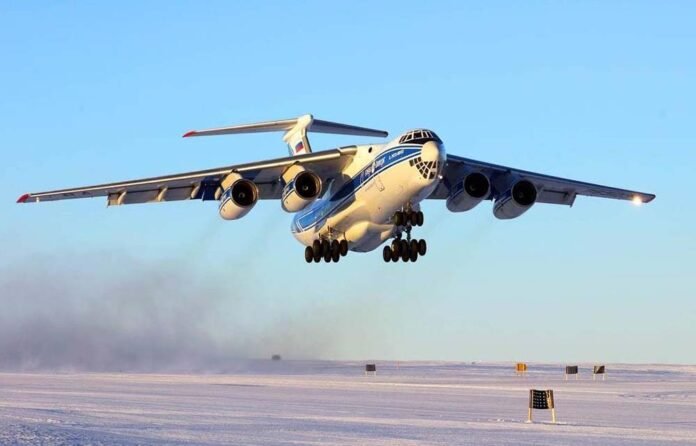India’s ambition to sustain its Ilyushin IL-76 transport aircraft fleet well into the 2040s represents a complex interplay of domestic engineering initiatives and continued technical cooperation with Russian aerospace organisations. The IL-76, which has been a reliable component of the Indian strategic airlift since the early 1980s, is currently confronted with the challenges of age and obsolescence, particularly in the areas of engines, avionics, and structural fatigue. However, a realistic life extension is achievable through a combination of progressive localisation, collaborative maintenance, and modern enhancements.
The Enduring Significance of the IL-76
The IL-76’s four-decade service in the Indian Air Force is indicative of its critical role in the provision of airlift support during crises, military logistics, humanitarian operations, and personnel movement. Despite decades of use, the type continues to be essential for rapid deployment capabilities as a result of its adaptability across terrains, payloads, and ranges. Nevertheless, the aircraft are currently restricted by outdated avionics and aging D-30KP engines, which are unable to satisfy the latest air traffic control and efficiency standards. The wear on airframes, landing gear, and internal structures underscores the urgent necessity for systematic restoration and modernisation.
The continuation of operations depends on successfully improving key systems and keeping the aircraft’s structure strong without having to replace the entire fleet. India is increasingly attempting to assume responsibility for maintenance and support through its private sector, although both objectives necessitate technical collaboration with Russia, the original manufacturer.
The Technical Challenge: Airframes and Engines
The most critical constraint on the IL-76’s future service is the D-30KP engine, a development from the 1970s. The mission capability is diminished by the following: increased maintenance cycles, restricted operational altitude, and reduced fuel efficiency as a result of the deteriorating compressor components. Upgrading to modernised engine solutions under Russian support has been proposed, though concrete engine-replacement programmes for the Indian fleet are still under evaluation.
The IL-76, which has been a reliable component of the Indian strategic airlift since the early 1980s, is currently confronted with the challenges of age and obsolescence, particularly in the areas of engines, avionics, and structural fatigue
Nevertheless, no domestic Indian company manufactures or services high-bypass turbofan engines of this nature. Continuous imports or licensed maintenance from Russian suppliers is therefore necessary for engine overhaul and sustainment. Industrial capability for full domestic production remains a long-term objective rather than a near-term reality. India’s IL-76 modernisation is contingent upon a consistent and dependable logistics channel from Russia in the absence of this capability.
Another challenge is the fatigue of the airframe. Microstructural degradation, corrosion in fuselage joints, and accumulated tension on wing spars are all common occurrences in aircraft that are approaching the 40-year mark. Access to the original manufacturing data and sophisticated non-destructive inspection systems is necessary for the evaluation of this degradation. Current domestic overhauls can restore capability; however, they are unable to independently recertify extended flight hours beyond the original design limits without external confirmation from the type’s engineering authority.
Initiatives for Domestic Modernisation
In the past few years, India’s private aerospace and defence sector has demonstrated a limited but increasing level of expertise in the repair of heavy transport aircraft. Early joint programmes have enabled Indian firms to undertake selective airframe repairs and small-scale avionics improvements under Russian technical oversight. This represents a growing shift from the outsourcing of all overhaul cycles to the implementation of incremental repairs within India.
Indian aerospace facilities are currently modernising onboard systems. The upgrades designed to comply with the changing international flight regulations include digital navigation aids, satellite communication terminals, and enhanced flight instrumentation. The technology disparity between India’s legacy transports and modern platforms is reduced by these incremental changes, which enhance operational safety and reduce pilot workload.
The most critical constraint on the IL-76’s future service is the D-30KP engine, a development from the 1970s. The mission capability is diminished by the following: increased maintenance cycles, restricted operational altitude, and reduced fuel efficiency as a result of the deteriorating compressor components
Nevertheless, certification for these modifications—particularly those that impact flight-critical systems—continues to be externally regulated. The original design authorities supervise the allowance limits for structural reinforcement, stress margins, and system integration integrity.
Collaborative Repair and Certification Framework
The strategic roadmap that India appears to follow is one grounded in joint responsibility. Indian firms conduct physical repairs, modifications, and integration under technical supervision, while Russian specialists continue to conduct the most stringent inspections and airworthiness assessments of Indian aircraft.
The necessity for licensing in critical domains, such as engine management software, airframe stress modelling, and avionics signal encryption, reinforces this partnership model. To legally continue operations beyond pre-approved service hours, India must adhere to original certification frameworks, despite its increasing capabilities in software and flight control modernisation.
The life-extension approach entails the disassembly of each airframe for internal inspection, the replacement of fatigued sections, the recalibration of load-bearing frames, and the reinstallation of the airframe under new service documentation. The fleet’s extended viability could be aligned with a late-2030s to early-2040s target horizon by implementing refurbishments, contingent upon the condition of each aircraft.
Procedures for the Renewal of Avionics and Structural Systems
Modernisation necessitates the integration of digital flight management systems and advanced avionics. Data-linked communication systems, electronic flight instrument systems, and contemporary glass cockpit configurations are scheduled for installation during overhauls. These enhancements enable more efficient mission planning that aligns with global airspace management standards.
Another challenge is the fatigue of the airframe. Microstructural degradation, corrosion in fuselage joints, and accumulated tension on wing spars are all common occurrences in aircraft that are approaching the 40-year mark. Access to the original manufacturing data and sophisticated non-destructive inspection systems is necessary for the evaluation of this degradation
Where feasible, improved materials and corrosion-resistant replacements are introduced, helping sustain structural integrity. Resilience against disruptions in foreign supply is being gradually strengthened by redesigning hydraulic and electrical systems with components that are either locally manufactured or sourced for increased durability.
Potential airframe modifications for future engine upgrades are under study, reflecting the IL-76’s robust baseline design while acknowledging that large-scale implementation remains tied to Russian support.
The Role of Domestic Industry and Strategic Self-Reliance
A realistic long-term strategy is based on the growing aerospace ecosystem in India, which includes private industry, public sector units, and certification authorities. Facilities certified under national airworthiness standards are gradually taking on responsibilities previously assigned to foreign facilities. This shift enhances the resilience of sustainment operations and cultivates crucial technical skills.
The IL-76 modernisation is a test case for how the private sector can help with strategic assets. The government is pushing for more domestic capability development to support this. Long term, indigenous aircraft programmes could apply the IL-76’s maintenance lessons, thereby bolstering both the civil and military sectors.
Complete independence remains restricted due to constraints on engine manufacturing, digital avionics architecture integration, and certification authority. The upcoming decade in India is expected to be characterised by a model of controlled cooperation, which will be complemented by domestic strength in less sensitive areas, rather than complete autonomy.
Indian aerospace facilities are currently modernising onboard systems. The upgrades designed to comply with the changing international flight regulations include digital navigation aids, satellite communication terminals, and enhanced flight instrumentation
A Practical Perspective for the Year 2040
The practical approach to ensuring the IL-76’s viability into the late 2030s and potentially the early 2040s involves selective modernisation with foreign collaboration. The combined supervision of engine procurement, system maintenance, and structural reinforcement achieves the most economical and safe lifecycle extension. Although the acquisition of wholly new platforms is still time-consuming and costly, the upgrading of existing IL-76 aircraft offers a flexible bridge between current requirements and future indigenous transport development.
In this framework, India can maintain a strategic lift capability that is both limited and dependable while also benefiting from the development of domestic maintenance expertise. Maintaining fleet health requires consistent funding, uninterrupted technical cooperation, and the development of domestic expertise in maintenance sciences.
The IL-76 modernisation is a test case for how the private sector can help with strategic assets. The government is pushing for more domestic capability development to support this. Long term, indigenous aircraft programmes could apply the IL-76’s maintenance lessons, thereby bolstering both the civil and military sectors
In conclusion
If pursued through a balanced partnership model, it is technically feasible to extend the IL-76’s lifespan into the next decade and potentially toward 2040, depending on individual fleet condition and available support. The aerospace industry in India has reached a state of maturity in which it is capable of managing significant portions of systems integration, modernisation, and maintenance. However, the primary enablers—engine support, thorough inspection technology, and certification—continue to be contingent upon collaboration with Russian engineering entities. India can ensure the operability of its IL-76 fleet and facilitate the eventual development of indigenous replacements by adopting a pragmatic combination of national capability and trusted external support. This equilibrium of strategic partnership and technological independence guarantees the aircraft’s continued effective service throughout its expected extended life.
The writer is the Publisher of Frontier India and the author of the book Foxtrot to Arihant: The Story of Indian Navy’s Submarine Arm.






